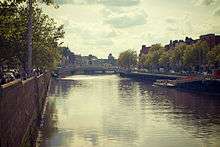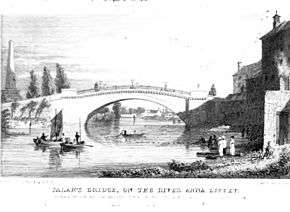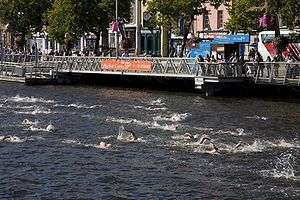River Liffey
| River Liffey | |||
|---|---|---|---|
 Boardwalks of Liffey and O'Connell Bridge, in Dublin | |||
| Basin | |||
| Main source | Kippure, County Wicklow | ||
| Source elevation | ~500 m (1,640 ft) (much at 0 to 30m) | ||
| River mouth | Irish Sea at Dublin Bay | ||
| Size | 1,256 km2 | ||
| Country | Ireland | ||
| Physiognomy | |||
| Length | ~125 km (75 mi) | ||
| Tributaries |
| ||
The River Liffey (Irish: An Life) is a river in Ireland, which flows through the centre of Dublin. Its major tributaries include the River Dodder, the River Poddle and the River Camac. The river supplies much of Dublin's water, and a range of recreational opportunities.[1]
Name
The river was previously named An Ruirthech, meaning "fast (or strong) runner".[2] The word Liphe (or Life) referred originally to the name of the plain through which the river ran, but eventually came to refer to the river itself.[3] It was also known as the Anna Liffey,[4] possibly from an anglicisation of Abhainn na Life, the Irish phrase that translates into English as River Liffey.[5]
Annalistic references
See Annals of Inisfallen (AI)
- AI808.2 A defeat [inflicted] by the Laigin on Aed, son of Niall, at the river of Liphe.
Course and system
The Liffey rises in the Liffey Head Bog between Kippure and Tonduff in the Wicklow Mountains, forming from many streamlets at Sally Gap. It flows for 132 km (82 mi)[6] through counties Wicklow, Kildare and Dublin before entering the Irish Sea at its mouth at the midpoint of Dublin Bay, on a line extending from the Baily lighthouse to the Muglin Rocks. It crosses from County Wicklow into County Kildare at Poulaphouca and from County Kildare into County Dublin at Leixlip, with most of its length being in Kildare.
The catchment area of the Liffey is 1,256 km2.[7] The long term average flow rate of the river is 18.0 m3/s.[7]
Tributaries
The Liffey system is a substantial one, including dozens of smaller rivers and streams.
Early tributaries include the Athdown Brook, Shankill River, Ballylow Brook, Brittas River and Woodend Brook, as well as the substantial King's River. Downstream of Poulaphouca are the Lemonstown Stream, Kilcullen Stream and Pinkeen Stream, followed by the Painestown River (with tributaries including the Morell River), Rye Water (with tributaries including the Lyreen), and the Griffeen River.
Within Dublin are the various Phoenix Park streams on the left bank, interspersed with right bank tributaries such as the Glenaulin Stream and Creosote Stream.[8]
Within the quays area tributaries include the River Camac, possibly Colman's Brook, the Bradoge River, River Poddle, Stein River and the River Dodder, some of which have numerous tributaries of their own.
In earlier times, the River Tolka was also arguably a tributary of the Liffey, or at least shared its mouth, but it now enters Dublin Bay distinctly, some distance to the north.
Dams, reservoirs and falls
There are dams for three ESB hydroelectric power stations along the river, at Poulaphouca, Golden Falls and Leixlip. Major reservoir facilities also exist at Poulaphouca. The Liffey does not feature natural lakes, and has few islands.
Significant falls at Poulaphouca and at Golden Falls were flooded by reservoir construction. There remain areas of rapids, notably as the river approaches Dublin city.
Settlements
Towns along the river include Ballymore Eustace, Athgarvan, Kilcullen, Newbridge, Caragh, Clane, Celbridge, Leixlip and Lucan before the river reaches the city of Dublin as it approaches its mouth.

Navigation and uses
The River Liffey in Dublin city has been used for many centuries for trade, from the Viking beginnings of the city up to recent times. It is connected to the River Shannon via the Grand Canal and the Royal Canal.
Water supply
Around 60% of the Liffey's flow is abstracted for drinking water and to supply industry. Much of this makes its way back into the river after purification in wastewater treatment plants. A popular myth is that Liffey water is used to brew Guinness but this is not true as Guinness uses water piped from the Wicklow mountains.[9]
Electricity generation
ESB hydroelectric power stations exist along the river, at Poulaphouca, Golden Falls and Leixlip, in addition to a number of minor private installations.
Traffic

A well-known sight on the Liffey up to the 1990s, the Lady Patricia[10] and Miranda Guinness[10] cargo ships were used to export Guinness from the St. James's Gate Brewery.
In recent years, the only regular traffic on the river within the city is the Liffey Voyage water tour bus service, which runs guided tours along the River Liffey through Dublin City centre. Departing from the boardwalk downstream of the Ha'penny Bridge, the Spirit of the Docklands runs under O'Connell Bridge, Butt Bridge and the Talbot Memorial Bridge on a journey downstream, passing the Custom House before turning at the Grand Canal Basin and back up stream. Built by Westers Mekaniska in Sweden, this 50 passenger water taxi, has variable ballast tanks (not unlike a submarine) and an exceptionally low air draught which means that at low tide it can float high, but at high tide it can ride low and still pass smoothly below the Liffey bridges.
Downstream of the East-Link bridge, the river is still mainly used for commercial and ferry traffic, with some recreational use also. High speed trips out the mouth of the Liffey are also available from Sea Safari.[11]
Recreational use

Upstream from the city, at Chapelizod, the river is used by private, university and Garda rowing clubs.
The Liffey Descent canoeing event, held each year since 1960, covers a 27 km (17 mi) course from Straffan to Islandbridge. The Normal Tidal Limit (NTL) of the river is Islandbridge (weir). The Liffey Swim takes place every year in late August or early September between Watling Bridge and The Custom House.The Islandbridge stretch of river accommodates a number of rowing clubs including Trinity College, UCD, Commercial, Neptune, and the Garda rowing club
The Liffey is widely used for recreational activities – such as canoeing, fishing, swimming, significant facilities are at Poulaphouca, Kilcullen, Newbridge,where a substantial seven acre Liffey Linear Park has been developed, and other facilities are available further downriver at Leixlip and other towns.
Crossings
History
The earliest stone bridge over the Liffey of which there is solid evidence was the Bridge of Dublin (on the site of the current Fr. Mathew Bridge), built by the Dominicans in 1428, which survived well into the 18th century.[12] This bridge with four arches included various buildings such as a chapel, bakehouse and possibly an inn[13] and replaced an earlier wooden bridge (Dubhghalls Bridge) on the same site. Island Bridge (a predecessor of the current bridge) was added in 1577. With the development of commercial Dublin in the 17th century, four new bridges were added between 1670 and 1684: Barrack, or Bloody Bridge, (the forerunner of the current Rory O'More Bridge), Essex Bridge (Grattan Bridge), Ormond Bridge (O'Donovan Rossa Bridge) and Arran Bridge. The oldest bridge still standing is the Mellows Bridge, (originally Queens Bridge) constructed in 1764 on the site of the Arran Bridge, which was destroyed by floods in 1763. The first iron bridge was the elegant Ha'penny Bridge built in 1816. The newest bridge is the Samuel Beckett Bridge opened in December 2009. A suspension bridge, it swivels to allow river traffic to pass.[14][15]
Present day

Dividing the Northside of Dublin from the Southside, the Liffey is today spanned by numerous bridges, mostly open to vehicular traffic. Notable are the West-Link Bridge on the M50 motorway, the Seán Heuston Bridge and O'Connell Bridge. There are 3-foot-bridges in the city: the Millennium Bridge, the Seán O'Casey Bridge and the Ha'penny Bridge. In December 2009, the new Samuel Beckett Bridge opened. between the Seán O'Casey Bridge and the East Link Bridge, It was designed by Santiago Calatrava Valls, who also designed the James Joyce Bridge that spans the Liffey. The Samuel Beckett Bridge takes both road and pedestrian traffic and in the future it may also take rail traffic.
Crossings further upriver include the Liffey Bridge at Celbridge, "The Bridge at 16" (a 19th-century pedestrian suspension bridge at what is now the K Club), and the Leinster Aqueduct – which carries the Grand Canal over the Liffey at Caragh.[16]
In the last 25 years much art has been added near the river. Some of the more famous works include the Famine Memorial Statues and the World Hunger Stone.[17]
Quays
The song about Seamus Rafferty refers to the "bowsies on the quay" – However, recent years have seen much development on the quays, with the addition of linear parks, and overhanging boardwalks which give the river banks renewed life.
There are quays on the North bank and the South bank of the Liffey, extending from the weir at Islandbridge to Ringsend bridge over the river Dodder, just before the East Link Toll bridge.
From West to East, the quays on the Northern Bank are: Bridgewater, Wolfe Tone, Sarsfield, Ellis, Arran, Inns, Ormond Upper, Ormond Lower, Bachelors Walk, Eden, Custom House, and North Wall.
From West to East, the quays on the Southern Bank are: Victoria, Usher's Island, Usher's, Merchants, Wood, Essex, Wellington, Crampton, Aston, Burgh, George's, City, Sir John Rogerson's, and Great Britain.

Incidents
In December 2000 a Bus Éireann bus, crossing the Liffey at Butt Bridge, collided with another bus and skidded into the Liffey. There were a few injuries but no one was killed.[18]
In July 2011 a homeless man rescued his pet rabbit from drowning in the river, after it was thrown into the river by a passerby. The man dived off O'Connell Bridge into the river in front of hundreds of people, and became a celebrity due to the circulation of videos of the rescue on the internet. The man had been homeless on the streets of Dublin for 22 years, and received an honour for his actions,[19][20][21][22] as well as being offered a job at an animal shelter.[23][24][25] The passerby who threw the rabbit into the river was arrested.[26]
Popular culture references

From Joyce to Radiohead, the Liffey is often referenced in literature and song:
"riverrun, past Eve and Adam's, from swerve of shore to bend of bay, brings us by a commodius vicus of recirculation back to Howth Castle and Environs."
That is the first of countless references to the Liffey in the Wake: insofar as the book has characters, the female protagonist of the novel, Anna Livia Plurabelle, is herself an allegory of the river.
A skiff, a crumpled throwaway, Elijah is coming, rode lightly down the Liffey, under Loopline Bridge, shooting the rapids where water chafed around the bridgepiers, sailing eastward past hulls and anchorchains, between the Custom House old dock and George's quay.
She asked that it be named for her. – The river took its name from the land. – the land took its name from the woman.
That there, that's not me – I go where I please – I walk through walls, I float down the Liffey – I'm not here, this isn't happening
"Somebody once said that 'Joyce has made of this river the Ganges of the literary world,' but sometimes the smell of the Ganges of the literary world is not all that literary."
"No man who has faced the Liffey can be appalled by the dirt of another river."
"But the Angelus Bell o'er the Liffey's swell rang out through the foggy dew."
"You can keep your Michael Flatley with his tattoos on his chest
Fare thee well, Sweet Anna Liffey, it's the Ganges I love best
I found a place in India so far across the foam
You can call me Punjab Paddy, boys, I'm never comin' home!"
Fare thee well sweet Anna Liffey, I can no longer stay
I watch the new glass cages, that spring up along the quay
My mind's too full of memories, too old to hear new chimes
I'm part of what was Dublin in the rare ould times

See also
References
| Wikimedia Commons has media related to Liffey. |
- ↑ River Liffey Information Retrieved 25 January 2013.
- ↑ Dublin Castle – Prehistoric Dublin – Chapter 1 Archive copy at the Wayback Machine
- ↑ Byrne, F. J. 1973. Irish Kings and High-Kings. Dublin. p.150
- ↑ As indicated by the caption of an engraving published in 1831
- ↑ Seanad Éireann – Vol 159, May, 1999 – Motion on National Archives – David Norris (senator and Trinity lecturer) referencing Georgian Society records
- ↑ Ordnance Survey of Ireland: Rivers and their Catchment Basins 1958 (Table of Reference)
- 1 2 South Eastern River Basin District Management System. Page 38
- ↑ River Liffey 25 January 2013
- ↑ "The Beer". Retrieved 31 May 2013.
- 1 2 IrishShips.com – Background on the Guinness boats on the Liffey
- ↑ Sea Safari
- ↑ Phillips M, Hamilton A. Project history of Dublin's River Liffey Bridges, Proceedings of the Institution of Civil Engineers – Bridge Engineering 156, December 2003, issue BE4, pages 161–179.
- ↑ Liffey Bridges Survey team (1987). The Liffey Bridges. p. 4.
- ↑ Irish Times – Samuel Beckett Bridge opens – 11 December 2009
- ↑ Dublin City Council – Samuel Beckett Bridge
- ↑ River Liffey Information Retrieved 25 January 2013.
- ↑ Kaufman,R 2014. Kaufman Green Guide Dublin. p. 132
- ↑ RTE News: Investigation launched into bus crash
- ↑ "Honour for homeless hero who rescued rabbit". Evening Herald. Retrieved on 12 July 2011.
- ↑ "ARAN awards homeless Dubliner". Newstalk. Retrieved on 12 July 2011.
- ↑ "Award for Homeless Hero". 98FM. Retrieved on 12 July 2011.
- ↑ "Reward for river rabbit rescuer". The Irish Times. Retrieved on 12 July 2011.
- ↑ "Rabbit rescuer offered job at animal shelter". The Irish Emigrant. Retrieved on 12 July 2011.
- ↑ "Rabbit river rescue hero is offered animal care job". Evening Herald. Retrieved on 12 July 2011.
- ↑ "JOE: Homeless rabbit rescuer offered animal farm job". Retrieved on 12 July 2011.
- ↑ "Award for River Liffey rabbit rescuer". RTÉ News. Retrieved on 12 July 2011.
External links
| |||||||||||||||||||||||||
| ||||||||||||||||||||||||||||||
| ||||||
